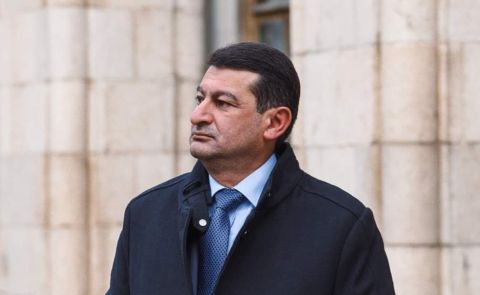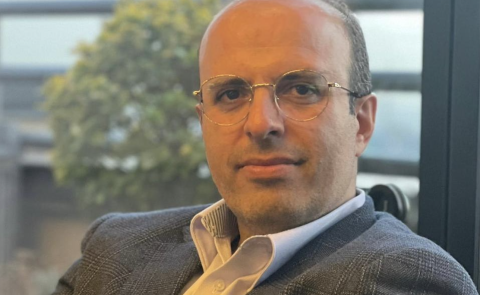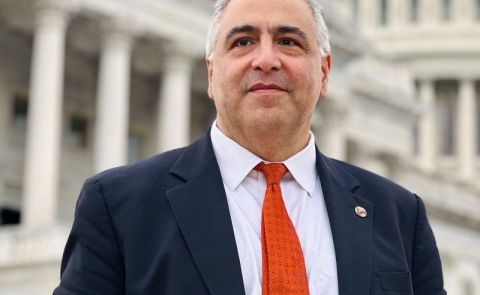
Aleksandr V. Gevorkyan: Why Diaspora Bonds Fail

Conflict and socio-economic hardship motivate people to move. This has been a big part of European history. Sometimes such population movements are followed by attempts by those who have left to support their home countries through various development projects. Most practically, in recent years there has been an increase in remittances, or 'solidarity capital', the money that those who have left send back home to support their families and loved ones.
Personal remittances account for a significant share of GDP in the post-Soviet space, not least in the South Caucasus. The trend has been strong since the onset of market reforms in the early 1990s and with renewed geopolitical tensions in the region. According to the World Bank, remittances in Armenia increased from $1.3bn to $2.03bn between 2020 and 2022; in Azerbaijan, remittances increased from $1.4bn to $3.95bn over the same period; in Georgia, this capital inflow increased from $2.1bn to $3.85bn. In relative terms, remittances shot up to a double-digit share of GDP. The upward trend continued in Georgia in 2023, while it declined in Armenia and Azerbaijan.
To understand the legacy and significance of this "solidarity capital" and the role that national diasporas play in economic development, we turn to Professor Aleksandr V. Gevorkyan, PhD, Professor and Henry George Chair in Economics at the Peter J. Tobin College of Business at St. John's University in New York City. Professor Gevorkyan is a macroeconomist specialising in the problems of economic development of post-socialist economies and "diaspora economics". His work informs policy-making and he has contributed to widely referenced policy papers published by the International Organisation for Migration, the United Nations Economic Commission for Europe and other development groups.
The collapse of the USSR brought socioeconomic unrest and mass waves of migration. This phenomenon created many Diasporas. What is so specific about the term “Diaspora” in an Armenian rather than more broadly post-Soviet setting?
For many post-Soviet states, the term Diaspora is new. Moldova, for instance, discovered the term 15-20 years ago, when their labour migrant communities swelled and started building relations with their homeland. For Georgia, similarly, Diaspora is a post-socialist phenomenon, with a recent rise in engagement with the country.
It is important to also clarify what we mean by diaspora here. We can refer to diaspora as a network of culturally or nationally affiliated individuals with some common background, living outside of the borders of their perceived native land. That sparsely distributed group withstands the test of time maintaining its cultural, religious, national, geographic, or other unique identity.
For Armenians the ‘Diaspora’ in that sense dates back millennia. One could point to the starting in the early 4th century of continuous Armenian presence in Jerusalem, which later evolved into creation of the city’s Armenian Quarter. Equally important is to note the scattering of the Armenian autonomous principalities on the shores of the Mediterranean starting approximately in the 11th century. The broad reach and established residences of the Armenian merchant networks—from the 15th through the 19th centuries across Europe’s medieval Italy, Netherlands, Poland, then on to Russia, Persia, India, and all the way to Hong Kong and Southeast Asia—played an enormous role in shaping the foundations of the modern diaspora.
The latter emerges on a larger scale than ever before in the early 20th century, following the catastrophe of the Armenian Genocide, with an even greater dispersion of communities from the historical Armenia, into the North and South America, Australia, Ethiopia, Russia, and across Europe. Since 1991 independence, ‘new’ waves of migration now from the Republic of Armenia and Artsakh are often adding to those already established ‘old’ communities or creating new small scale diasporic nodes across the Americas, Middle East, France, UK, Russia. In fact, while I estimate about four and a half to five million people of Armenian descent living in the diaspora, there are close to two million people of Armenian identity in Russia alone. Some of those communities date their origins back into the 18th century.
Incredibly, the majority of these people have never been born or lived in Armenia and some may not even speak Armenian and have never visited the country. The potential is vast and my own work with two independent online diaspora surveys suggests people have strong interest in engaging with the present-day Armenia, despite being also Brazilian or British in their background. Shared history seems to matter in shaping one’s identity.
Overall, the relationship of a dispersed community and the nation-state considered a homeland relates to the experience of migration. Aside from Roger Brubaker’s classical “Diaspora Nations” – Armenian, Jewish, Greek—we now also have diaspora communities shaped by the post-Soviet political and economic realities.
In countries like Estonia, Bulgaria, and Moldova, with no historical references to a Diaspora culture, the term merely refers to scattered populations of recent immigrant communities. There is a much more direct link to the country of origin, where the first-generation migrants were born. Moldovan migrants across Italy, Romania, Russia, and elsewhere makeup this latest labour migration diaspora. You see similar patterns across other South-eastern European and Central Asian countries, all born out of the 1990s socioeconomic post-socialist transformations.
Here, there are somewhat similar financial or cultural mechanisms through which people connect with their homelands. Some are more advanced than others. Moldovans, for instance, who usually come from rural areas, are organised abroad in hometown associations. Leveraging these institutions, Moldova and with support of multilateral groups has created an effective system capturing labour migrants’ remittances towards local development.
Such economies like Poland have broader policy measures in place supporting their diaspora communities and encouraging multifaceted engagement with the country, including repatriation. Elsewhere, are attempts to capture diaspora’s intellectual capital through joint scientific projects.
Creating a sense of urgency, the Covid pandemic had a strong effect across modern and historical Diasporas. In the host countries, in a position of relative stability, many of the diaspora communities watched how the pandemic unfolded in their ancestral homelands and were driven to act in support.
Across Central and Eastern Europe, there began a process of welcoming repatriation and financial assistance, both due to Covid and, earlier, Brexit. In the Caucasus we see the mobilisation through professional associations – doctors, lawyers, academics – to support a ‘homeland in need.’ In Armenia, the added crisis was the second war in Nagorno-Karabakh Republic in October 2020, which led to diaspora’s wide-scaled humanitarian response.
In sum, the mechanisms through which diaspora connects with its ancestral homeland and how individuals in the diaspora join those networks as self-aware members are very dynamic and differ across communities.
If Diaspora groups are so complex, is it accurate to speak of a “brain drain” when we describe the migration of a country’s most educated and trained elite? Is this relationship between the “home country” and the new country a zero-sum relationship?
In the past it was zero sum. These days, it’s not as much. Recall that we have a “home country” where people are from, and a “host country,” where people live.
For the small economies like Armenia, Bulgaria, Estonia, Georgia, Moldova, Romania, and others, the 1990s and early 2000s was the period that is often associated with the “brain drain”. This was the decade of massive population swaps between countries and, sadly, often, it was the most successful and educated that left for abroad, in search of institutional stability. Lately, some individuals from this post-independence migration, are re-connecting with their home countries.
Due to the differences of the Armenian diaspora, often predating the post-socialist transition of the 1990s, not everyone of Armenian descent is motivated to engage with Armenia. But those who do, make a difference. For example, though the high-tech sector accounts for a really small share of Armenian economy’s GDP and its effect is sometimes overstated, the 2% of the Armenian labour force working in the IT earn higher wages with skills that weigh strongly on the country’s development. This growth, built on the foundation of Armenia’s Soviet technical education and experienced workforce in the field, has been reinvigorated over the last two decades through direct engagement of Armenian diaspora-based entrepreneurs.
Elsewhere, winemakers from the Armenian diaspora in Italy and the U.S. nearly single-handedly relaunched Armenia’s wine sector. Two American-Armenian groups have revamped tourism and Armenian traditional carpet making industries. The country has seen a large inflow of Syrian and Lebanese Armenians, leading the way in the light textiles and hospitality sectors. Russian-Armenian and American-Armenian diaspora groups are active in the country’s business development, trade, and higher education sectors. There is a very long list of examples.
Indeed, a mix of old and new Diasporas engagements may in some way be reversing the earlier “brain drain” waves, triggering significant changes. But there are no guarantees and each experience of interaction with their diasporas remains unique.
Remittances make for a big share of the GDP in many post-Soviet states. In some Central Asian polities, it is 30%. In the Caucasus it is often more than 5%. Is there a way to use this “solidarity capital” to develop the country or this is just lost in consumption?
Over the last 25 years, remittances accounted for approximately 35% of Tajikistan’s GDP; this number is around 20% in Moldova. Over the same period, the number for Armenia and Georgia is closer to 10%.
The question of what is the “legacy” of this solidarity, as you refer to it. The World Bank consistently reminds us that remittances are surging along with migrants and that this is a reliable flow of capital that contributes to development. This trend has led multilateral development groups to start focusing on the diaspora potential, placing much emphasis on the possible long-term impact of national diasporas for their countries of origin development. That is all fine, but, as I often say, migration is not a Diaspora, though Diaspora is born out of migration.
The first generation of the often-irregular migrants settle and send money back home. Once settled, migrants often bring their relatives and, over time, the settlement is formalised and there is less of an incentive to send money home. Second generation migrants, in the absence of direct recipients back home, often discontinue the flow of remittances, or remittances become more sporadic and are tied to specific causes. This is where the new diaspora engagement with the home country may take a long pause.
There are two exceptions: First exception pertains to new settlements in locations with ‘old’ diaspora presence (e.g., as examples of Armenia and now Moldova suggest), which embraces migrants and their families helping them preserve ties with the homeland.
The second exception is when there is active home country diaspora policy, which engages with both the old and the new diaspora, sustaining the loose and direct links. While many states of the post-socialist space are trying to effectively develop and implement such policies, the best practices come from countries like Ireland and the Philippines.
Sometimes, remittances have adverse effects. Money sent home will boost local consumption, often introducing inflation. Typically, for instance, you see real estate rising speculatively in value, few years after the first wave of migration. You also see an abnormal valuation of domestic currency, due to a large in relative terms share of foreign currency remittances. This inhibits development as it adds pressure on a weak macroeconomic structure.
However, there are also undeniable benefits. There are few flows of capital that are as effective as remittances in reducing individual poverty. About 25 years ago, more than half of the population in Armenia was benefitting from some support from an immigrant in the family, according to the World Bank’s estimates. Today, similar effects are visible in Moldova and Tajikistan, for example. The challenge is to scale such flows up to a structurally meaningful transformation in macroeconomic terms ensuring sustainable growth path for the country.
The big picture from the international experience, e.g., Mexico or Philippines, is that to make the most of these monetary transfers, one should be more intentional about the application of these capital flows. It may be possible to establish a development bank or set up an investment fund, focusing on infrastructure or education. Some of these models are reviewed across my research.
One of the popular ways of making the most out of remittances have been “Diaspora Bonds.” They have been used by Israel, Turkey, and India. What about the Caucasus?
Diaspora bonds worked mostly in Israel. Everyone else is trying. Greece and Armenia toyed with the idea of Diaspora bonds, as have several nations with sizable Diasporas, like Ethiopia, India, or Nigeria. In Armenia the idea resurfaces every few years. Often, the devil is in the details.
Take for instance Nigeria. The economy is founded on crude oil exports with a presence in the international debt markets. In this context, a Diaspora bond is evaluated within a broader national macroeconomic spectrum. Indeed, what is marketed as a diaspora bond becomes a general revenue government bond, which is accessible to all foreign investors. A pure diaspora bond, due to lack of interest or capacity from the diaspora investors, may carry a risk of sovereign credit rating downgrade, which would be ruinous to the country’s ability to borrow competitively.
In the 1990s, during a fiscally and geopolitically difficult moment, India opened up to its Diaspora; a reversal from a previous policy of exclusion anyone outside the country. This was a journey that would lead to the celebrated link between California’s Silicon Valley and India’s high-tech sector development. India’s diaspora bond, as a stand-alone security, was modelled more as an investment instrument through India’s banking system with limited scope, as far as an actual debt instrument, due to concerns over exchange rate risk, litigation, and impact on sovereign credit ratings.
Israel’s success with Diaspora bonds owes much to the clarity of what the state sought to accomplish with their financial instruments. Going back to the 1950s, Israel was a new state and through Diaspora bonds Israel sought was able to enter international capital markets and fundraise for development projects. These purpose-built securities were offered in transparent terms, a record that Israel has been able to sustain.
The first bond issue invited the solidarity of the global Jewish diaspora with the Jewish state, not least through massive outreach campaign by the state officials. The later issues were clearly framed as financing vehicles open to all becoming a prised asset across global investor portfolios, including some US municipalities. Naturally, secondary guarantees from the US Treasury, mentioned in the bonds’ prospectus, have helped with the program’s credibility.
Overall, creating a diaspora bond that can be trusted is no simple task; and it is more a question of trust than rather existent diaspora. A 10% return is not a sufficient condition to induce a typical affluent diaspora investor in the advanced economy. The stock market in the investor’s country of residence will help generate an even greater return, faster, and without major capital or ethical commitments. Even if the bond’s offering allows for smaller scale pledges of USD100 for example, the math would not work for a diaspora investor who is a priori hesitant about engagement with the home country for various, often personal, reasons.
But for a developing nation, if diaspora bond is a chosen model for attracting additional financing, there is a need for a difficult and large-scale grassroot work with the Diaspora, offering more than financial returns and simplified investment mechanisms. Instead, it should be willingness to work with community institutions, prioritizing home-to-diaspora trust building.
The key question to ask is ‘what does this asset offer today’ in comparison to other existing assets, which are technically accessible to foreign, diaspora, investors. When Israel launched its diaspora bond that was the way for the economy to enter the international markets. These days, most of the post-socialist countries, already have an established presence in the global markets. And, hence, there is hardly a need to expose to additional risk. And instead, the focus should be on macroeconomic development strategies. Failure at launch may severely damage the country’s debt profile, resulting in higher borrowing costs, lower capital volumes and impeding other types of investment flowing into the economy.
Living abroad, a diaspora community, whether old or new, might be able to maintain its cultural and national identity for some time. The success of that is determined by the strength of the diaspora-based institutions and home country’s interest towards its diaspora. But the diaspora-home engagement is predicated by mutual trust, which requires time and experience to evolve, and clarity of the engagement infrastructure that the home country puts forward to its diaspora. There are no simple solutions here. All of that demands a continuous innovative effort.
In the end, neither diaspora engagement nor diaspora bonds are a silver bullet. Diaspora can only be an element in national socio-economic development, but it cannot be a substitute for a clearly articulated and strategic development policy.
Interview conducted by Ilya Roubanis
See Also


Irina Mamulashvili: Electoral Interference is a Playbook, not a Recipe

Giorgi Gakharia: The EU Should Engage Georgia Despite Its Democratic Backsliding

Peace or Capitulation? Shahverdyan on Armenia-Azerbaijan Agreement and the Nagorno-Karabakh Crisis

Ali Mousavi Khalkhali: Iran Will Avoid Conflict in the Caucasus

